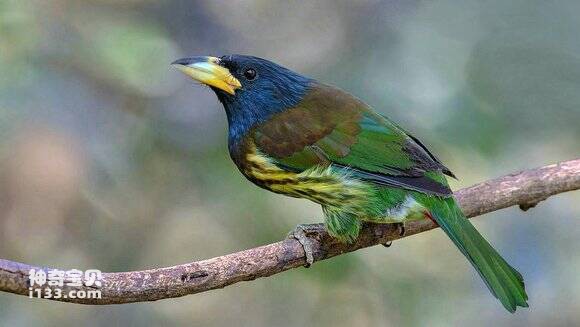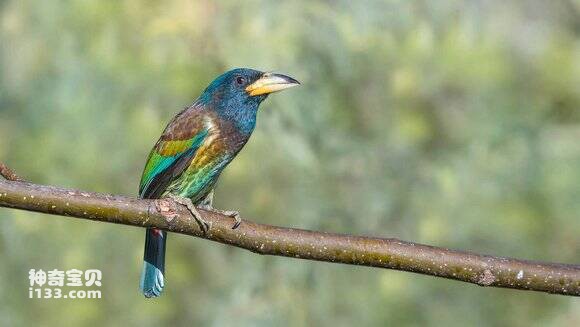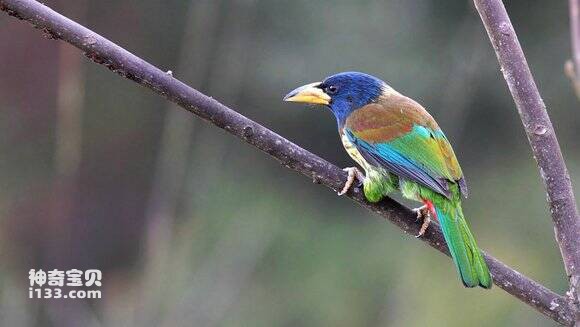Psilopogon virens
IUCN
LCBasic Information
Scientific classification
- name:Psilopogon virens
- Scientific Name:Psilopogon virens,Great Barbet
- Outline:Climbing birds
- Family:
Vital signs
- length:30-34cm
- Weight:150-230g
- lifetime:No textual research information is available
Feature
The call is monotonous and loud, and it is repeated 'go-o, go-o'
Distribution and Habitat
Worldwide distribution: It is distributed in Himalayan countries, Myanmar, Thailand and Indochina Peninsula.
Distribution in China: It is distributed in Yunnan, Guizhou, Sichuan, Anhui, Zhejiang, Fujian, Guangdong and southern Tibet.
Macropicus macropicus lives in low and mid-mountain evergreen broad-leaved forests below 1500 meters above sea level, and is also found in mixed coniferous broad-leaved forests, with the highest distribution altitude up to 2500 meters.
Appearance
The Megalomacus is 30-34 cm long. The mouth is large and thick, ivory or pale yellow; The whole head, neck and throat are dark blue or purplish blue, the upper chest is dark brown, the lower chest and abdomen are light yellow, with broad green or blue-green stripes; Red undertail cover. Back and shoulders dark greenish-brown, the rest of the upper body green. Head and neck blue or blue-green, feather base dark brown or black. The upper back and shoulders are dark greenish-brown or tinged with dark red. Lower back, waist, tail cover and tail feathers bright grass green. Tail stem dark brown. The inner medium and small coverts are the same color as the back, the inner large coverts are grassy green, and the apex is stained with chestnut brown; Dark brown feathers, inner feathers copper green or grass green; The outer end of the inner primary feather is gray or off-white. Upper thorax dark brown, lower thorax and abdomen central green or blue-green, and decorated with milky yellow, yellow
Details
Psilopogon virens, Great Barbet, has four subspecies (1. Megalaima virens clamator from Western Yunnan. This species is found in Yunnan Province. 2. Megalaima magnifica This species is found in India. 3. Megalaima virens marshallorum (Tibetan subspecies). This species is found in the Himalayas. 4. Named subspecies of Megalaima virens virens. This species is found in China.
)。

Macropicoides often live alone or in pairs, sometimes in small groups where food is abundant. It lives on top of tall trees and can stand on branches and move from side to side like a parrot. The call is monotone and loud, and is a constant 'go-o, go-o' call.

It feeds mainly on the flowers, fruits, and seeds of marmulberry, Acanthaceae, and other plants, as well as a variety of insects, especially during breeding.

The breeding period of the giant Woodpecker is from April to August. Breeding in pairs. Usually nesting in the mountain forest trees at an altitude of 300-2500 meters, more than their own holes in the trunk of the nest, sometimes also use natural tree holes. The height of the hole from the ground is between 3-18 meters, the diameter of the hole is about 7 centimeters, and the depth of the hole is 17 centimeters. Two to five eggs are laid per litter, with 3-4 eggs being the majority. The egg is white, the egg is oval, the size is 30-39 mm ×22-29 mm, and the male and female incubate the egg in turn. Young birds are late sex.
It was included in the List of Beneficial Terrestrial Wildlife under State Protection or of Important economic and scientific research Value issued by the State Forestry Administration of China on August 1, 2000.
Listed on the International Union for Conservation of Nature (IUCN) 2012 Red List of Threatened Species ver 3.1 - Not Threatened (LC).
Protect wild animals and eliminate wild meat.
Maintaining ecological balance is everyone's responsibility!








